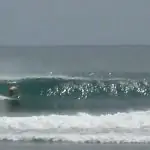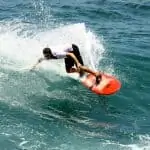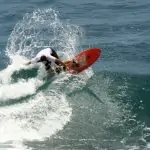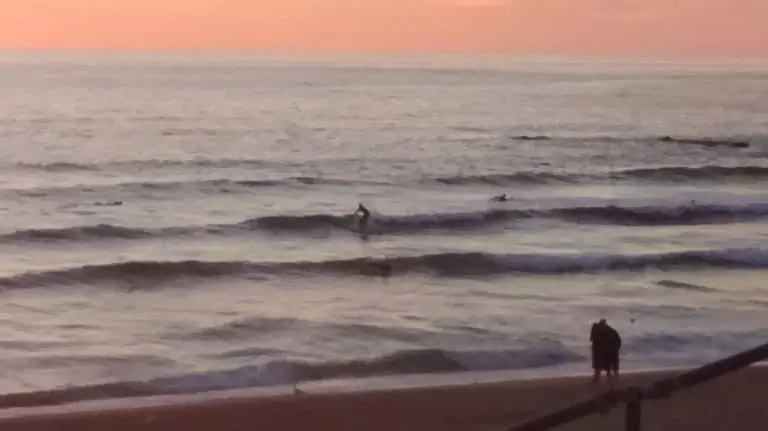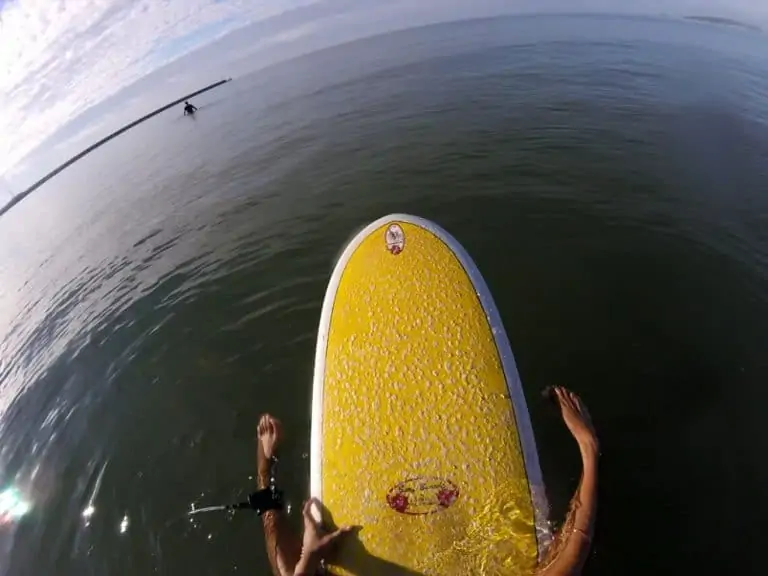Here’s How a Surfing Lineup Works (Every Detail)
Although surfing is quite simple by itself, there are lots of things to learn about surfing that many beginners struggle with.
For instance, understanding the surfing lineup, where all the surfers sit waiting for the best waves, is a key part of understanding how surfing works and how to have fun.
It may seem strange when you first start, but things soon become clear with a bit of explanation and time in the water.
So, in brief, how does a surfing lineup work?
People will gather near the best place to catch waves and must take it in turns. This ‘pecking order’ is determined by how long you’ve been surfing there, your ability and knowledge of the break. There are other factors, too, as we’ll get into below.
Surfing Lineup: Key Terms
Before jumping in, below is a quick breakdown of all the key terms you need to know for a surfing lineup:
| Term | Meaning |
| lineup | where surfers sit in a group (or ‘line’) to catch unbroken waves, usually 50 yards or more from shore. |
| take-off spot | exactly where surfers sit in the lineup to catch and ‘take off’ on a good wave; this can be a very small and crowded space, especially at reef breaks. |
| the peak | similar to the take-off spot above; a critical part of the lineup, exact spot where the waves start to break. |
| outside | beyond the breaking waves at a surf spot, needs surfers to be able to paddle out. Also called ‘out the back’. |
| inside | closer to shore than the breaking waves; in the whitewater. |
| snaking | when someone in the lineup jumps the queue and takes a wave when it’s not their turn. |
| hassling | paddling close to other surfers to pressure them into catching waves or letting someone else have them out of priority. |
| priority | the surfer in the right spot closest to the peak or breaking wave who has the right of way to catch and ride the incoming wave. |
Most are simple but can confuse the new surfer.
With that done, let’s get into the explanation of just how the lineup works in surfing.
Place and Positioning
A lineup at any given surf spot is concentrated around the best place to take off on waves.
This will be what surfers call ‘out the back’, so beyond the breaking waves. This is because it gives space for surfers to be able to paddle in to catch the waves, rather than the waves just dumping on their head or in front of them.
Because waves along most beaches will break in a similar spot at a given stage of the tide, the lineup will be quite concentrated.
How the lineup looks depends on the type of break. For instance, the different types of breaks and their lineups are listed below:
- Beach break: spread out in a line along the length of the beach; easiest to catch waves in.
- Point break: lineup usually runs down the length of the break; a bit more difficult to catch waves than in a beach break, often with currents.
- Reef break: extremely concentrated lineup, making it hard to get waves and often with a very tight take-off spot
- NB: a ‘takeoff spot’ is the small area where surfers will be catching waves and taking off in. This can be just a few square yards in some breaks.
Remember to do your best to survey the lineup from the beach before paddling out to get an idea of how the best place to sit and where you should position yourself to get waves.
Be sure to check out this super helpful post on how to surf a crowded lineup for more!
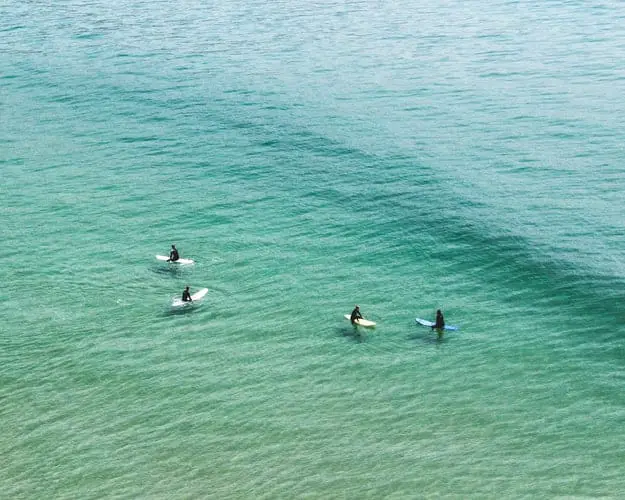
Taking Turns in the Lineup
As well as positioning, a surfing lineup also works through people taking turns to catch waves.
This works on something of a rotation basis, with someone catching a wave, riding it, then paddling back out.
In the meantime, other surfers will put themselves in position to catch any waves that come in that time.
This rotation also helps to determine ‘priority’, where the person who is next in line actually has something of a right of way to catch the next wave.
Of course, surfing is out in the ocean, so there aren’t strict rules and orders like on the roads but there is still some kind of organization to it all, so be sure to respect it.
Although this is largely unspoken, you will sense the order when you are out there if you are paying attention.
Ignoring the idea of taking turns in a lineup is a surefire way to get some angry looks, or worse, so don’t take this lightly.
In fact, ‘snaking’ is a surfing term to describe people who try to jump the queue in the lineup and paddle straight to the peak, cutting in and taking waves that they have not got the right to catch.
There are also others who sit too close to those with priority, trying to force them to take off in a very small space. This is often referred to as ‘hassling’ and is definitely not a good way to go, it is only surfing after all!
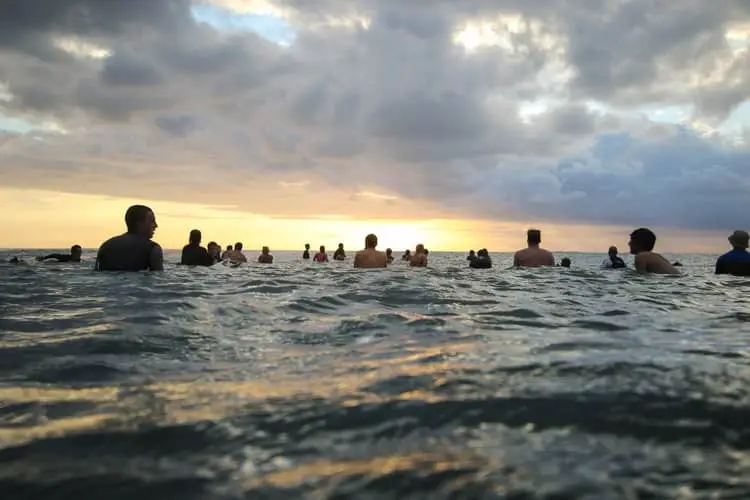
Locals
Locals in surfing are another key part of the lineup and people you need to give due respect to.
They are the people who either live nearby or, from having spent years at a certain break, have special status in the lineup because of time spent surfing there.
Although many locals are good, not all are the best surfers, but they should still be treated with respect.
Getting in their way will come at a cost and again make you an unwelcome ‘guest’ in the lineup.
If the locals turn against you because of your lack of respect, then you may as well paddle in simply because you will not be able to get many more waves after that.
Remember that you can’t just rock up and expect to have the red carpet treatment, especially when it is obvious that you are new or from somewhere far away.
Some locals will be friendlier than others but just give them due respect and try to stay out of the way and you should be OK.
For more extreme surf spots like Pipeline or heavier waves, the locals regulate the lineup in a serious way given how serious the waves are. So, if you are reading this blog, you are probably far from ready to paddle at a heavy spot!
Instead, take your time, learn the ropes and be respectful once you feel ready to paddle out in a certain lineup.
Ability
Surfing level or ability is another key factor in any lineup.
Good surfers will always be experienced and so will know where the best place to catch waves will be, making their positioning better.
Then, when they catch a wave, they will also do lots of advanced maneuvers and be able to control their board in a way that means they are not a threat to others.
This means that, even if they are not local to that spot, they don’t get in the way and therefore don’t annoy the locals.
Better surfers will almost always have a good level of fitness, too, so that makes it easier for them to paddle faster to catch waves and paddle back out quickly to get more.
For this reason, good surfers have a much easier time getting waves at spots around the world, even if they are new there.
Now, this doesn’t mean that being a good surfer means that you are able to rock up and treat any break like it’s your home.
Rather, good surfers get a bit more leeway because of their ability and knowledge of surfing, which comes through instantly.
On the flipside, new or beginner surfers will also stand out and get almost zero benefit of the doubt.
Beginners stand out in a lineup from how they paddle, the boards they ride, their positioning, as well as how they do things like duckdiving.
There is no way to hide your surfing level so simply paddle out into lineups where you fit in ability-wise. If you feel that you don’t belong, no worries – just paddle to another peak or head in to shore and go to another spot. There’s no point letting your ego get in the way and potentially cause an accident or harm to others, as well as getting you ‘blacklisted’ at a surf spot.
Summary
Be safe, be sensible and think about your own abilities before you head out into any surfing lineup.
It will get easier with time but there is no substitute for the improvements gained in the surf from the hours spent in the waves.
Along with this, you will get to see how all the different lineups work and start to understand where you can fit in and catch some waves.
Related Questions
How does the lineup at Pipeline work? Locals followed by the best surfers dominate the lineup. They decide who can go and when, as well as which waves to let go or not. If you get in the way, you risk a fight on the shore shortly afterwards.
This is because of how dangerous it is to get in people’s way at an already dangerous spot, making the locals fiercely enforce the rules of the lineup in any way they see fit
Although this might seem brutal to outsiders, it really can be a matter of life and death in the water, so don’t take it lightly or you may find yourself on an early flight home.
Why is Pipeline so deadly? It’s a combination of the shallow bottom over sharp coral and rocks, as well as the massive waves that roll in from storms in the Pacific. The power of the waves at Pipeline also adds to the danger, with the massive, open barrels on offer being packed with power.
On top of the above, because of how incredible the waves at Pipeline are, it is also one of the most crowded spots in the world, with everyone wanting some of the barrels on offer. This means that there are more boards and bodies in the water, with serious potential for accidents and collisions on every wave, adding to all the other hazards.
Remember: only paddle out at a spot like Pipeline if you are absolutely sure that you are ready. If there is any doubt, stay on shore and come back another day.


